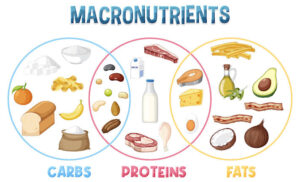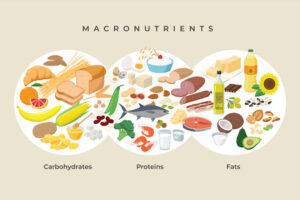Back to: ZOOLOGY 400 Level
Welcome to class!
Hello, my ever-curious champion! It’s so good to see you in class again. You’ve been learning some amazing things about how your body works, and today’s topic will give you even more power to make smart choices about food and health. We’re talking about Macronutrients and Micronutrients — the nutrients your body needs to grow strong, stay energised, and remain healthy. Whether you’re eating eba and egusi soup, rice and beans, or even fruits, your body is constantly drawing these nutrients from your food. Let’s understand how they work!
Macronutrients And Micronutrients
Macronutrients
Macronutrients are the nutrients your body needs in large amounts. They provide energy and are essential for growth, repair, and everyday body functions. There are three main types:

Carbohydrates: These are your body’s main source of energy. You get them from foods like yam, rice, cassava, and bread. After digestion, they become glucose which powers your cells.
Proteins: Proteins help build and repair body tissues, like muscles, skin, and organs. You get them from eggs, beans, meat, and fish. Proteins are made of amino acids, the building blocks of life.
Fats (Lipids): Fats give long-lasting energy, help absorb some vitamins, and protect organs. They’re found in palm oil, groundnuts, meat, butter, and avocado (pear).
Example: When you eat a plate of rice and beans with fried plantain, you’re taking in all three macronutrients — carbs (rice), protein (beans), and fat (oil from plantain).
Micronutrients
Micronutrients are needed in small amounts, but they are just as important. They don’t give energy, but they help your body use macronutrients properly and support immunity, growth, and brain function.
There are two main types:
Vitamins: These include vitamin A (for vision), vitamin C (for healing), vitamin D (for bones), and others. You find them in fruits, vegetables, fish, and eggs.
Minerals: These include iron (for blood), calcium (for bones), potassium (for muscles), and iodine (for thyroid function). You get them from meat, milk, vegetables, and salt.
Example: Oranges provide vitamin C, which helps your body fight infections. Milk gives calcium to keep your bones strong.

Why You Need Both
Your body can’t function well with only one type. Macronutrients give strength and energy, while micronutrients help your body process that energy and protect your health. That’s why a balanced diet — like eating vegetables with your jollof rice or having fruit after a meal — is so important.
Summary
- Macronutrients are needed in large amounts and include carbohydrates, proteins, and fats.
- They provide energy and support growth and repair.
- Micronutrients are needed in small amounts and include vitamins and minerals.
- Micronutrients help regulate body functions, support immunity, and prevent diseases.
- A balanced diet includes both macronutrients and micronutrients for good health.
Evaluation
- What are the three main types of macronutrients?
- Give one food source for each macronutrient.
- What are micronutrients and why are they important?
- Mention two examples each of vitamins and minerals.
- Why is it important to eat a balanced diet?
You’re doing an incredible job, and I’m really proud of your dedication! Keep learning, asking questions, and making healthy choices. You are not just studying — you’re preparing to become a strong, smart leader of tomorrow. With Afrilearn by your side, nothing can stop you. Shine on, superstar!
